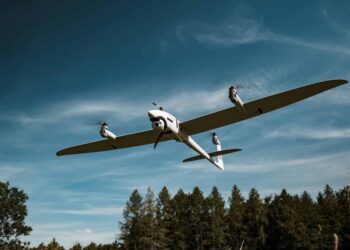Gulfstream Aerospace, SAVANNAH: Gulfstream Aerospace, a wholly owned subsidiary of General Dynamics, successfully completed the first flight of its Conformal Airborne Early Warning (CAEW) special mission aircraft on May 20, just three weeks after it was rolled out from a production hangar at the business-jet manufacturer's Savannah, Ga., headquarters.
This extensively modified large-cabin, ultra-long-range Gulfstream G550 jet aircraft will serve as the platform for the Israeli Ministry of Defense's (IMOD) AEW surveillance system.
According to Pres Henne, Gulfstream senior vice president programs engineering and test, the G550 is the ideal platform for this defense system. “The modified G550 CAEW platform and ELTA Systems' mission suite compete favorably with much more expensive older aircraft at considerably greater operating efficiencies,” Henne said. “For much lower acquisition and life-cycle costs, the CAEW G550 delivers higher altitude, longer range and loiter time and more effective electronic early warning systems.
“The combination of Gulfstream's excellent aerodynamic and payload performance and ELTA's state-of-the-art, proven conformal electronic systems deliver true 21st-century capabilities in a 21st-century platform.”
Gulfstream was awarded a contract in 2003 to supply CAEW aircraft to the Israeli Ministry of Defense. The contract included options that were recently exercised. Following extensive flight-testing, Gulfstream will deliver the first CAEW aircraft to ELTA Systems Ltd. at the end of August. ELTA Systems Ltd., which is a wholly owned subsidiary of Israel Aircraft Industries (IAI), will provide and install the mission electronic equipment.
“The CAEW platform requires endurance, must be highly reliable and have low operating costs,” Henne said. “The G550 fits the bill. The ultra-long-range G550 flies farther – nonstop from Tokyo to New York – than any other aircraft in its class and is backed by Gulfstream, a company that demands excellence in everything it does.”
Jehezkiel Grizim, general manager of ELTA's AEW division, said, “The ELTA sensor suite provides integrated, real-time information on air targets and is designed to fit the G550 platform. ELTA radar provides unique 360-degree coverage without aircraft obstruction, with conformal antennae, optimizing its performance through a dynamic beams allocation and allowing rapid target acquisition.”
The CAEW special mission aircraft features the most extensive exterior modifications on a Gulfstream aircraft to date, requiring multiple Federal Aviation Administration (FAA) supplemental type certificates and FAA-approved aircraft service changes. Gulfstream's dedicated special missions team increased the G550's maximum zero fuel weight; provided the structural attachments, racks and wiring; nearly tripled the electrical power by adding two additional generators; and installed a liquid cooling system for ELTA Systems' extensive electronic equipment.
These modifications were developed by Gulfstream engineers using state-of-the-art design tools, including a full CATIA electronic mockup, and computational fluid dynamics to ensure a high efficiency and a low drag. These modifications create the space, power supply and environment required to install and operate the electronic components that make the CAEW platform equal in capability to aircraft that weigh twice as much.
Gulfstream also was awarded a contract for Special Electronic Mission Aircraft (SEMA) from the Israeli Ministry of Defense in 2001. Gulfstream delivered the first SEMA platform to IMOD at a ceremony on May 23, 2005. A modified Gulfstream V (GV), the SEMA aircraft was produced to replace the Israeli Air Force's three aging Boeing 707 aircraft. Similar to the G550 CAEW platform, Gulfstream modified the GV SEMA aircraft to accommodate onboard mission equipment, also supplied by ELTA.
BEDEK Aviation Group, also a division of IAI, is providing maintenance and integrated logistic support for both the CAEW and SEMA aircraft.
The large cabin, ultra-long range G550 business jet was introduced in September 2002. It features the PlaneView flight deck and also the award-winning Gulfstream Enhanced Vision System. The G550 features a cabin volume of 1,669 cubic feet, with an additional 226 cubic feet of baggage space available; a maximum cabin altitude of 6,000 feet; 100 percent fresh air in the cabin; and 14 large oval windows that allow for a generous amount of natural light. As for performance, it can reach speeds up to Mach .885, cruise as high as 51,000 feet, and has a range of 6,750 miles.
More than 160 government and special mission Gulfstream aircraft are in service, in completion, or on order with 34 nations in a variety of roles including executive transportation, photo reconnaissance, maritime surveillance, medical evacuation, weather research, and astronaut training. The G550's robust construction, versatility and reliability make it highly desirable as a special mission and CAEW platform.
Gulfstream Aerospace Corporation, a wholly owned subsidiary of General Dynamics, designs, develops, manufactures, markets, services and supports the world's most technologically advanced business-jet aircraft. Gulfstream has produced more than 1,500 aircraft for customers around the world since 1958. The company employs more than 7,900 people at seven major locations.
General Dynamics, headquartered in Falls Church, Virginia, employs approximately 72,700 people worldwide and had 2005 revenue of $21.2 billion. The company is a market leader in mission-critical information systems and technologies; land and expeditionary combat systems, armaments and munitions; shipbuilding and marine systems; and business aviation.
Germany says adding explosive drones to weapons arsenal
Germany said Friday it would buy explosive drones for the first time as Berlin boosts investments in its armed forces...









